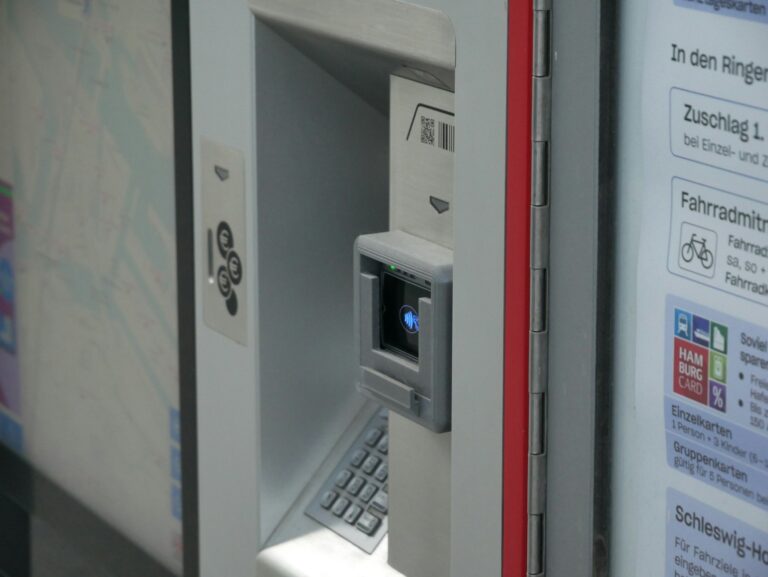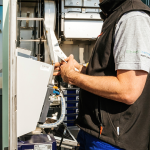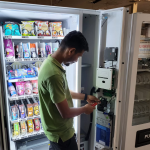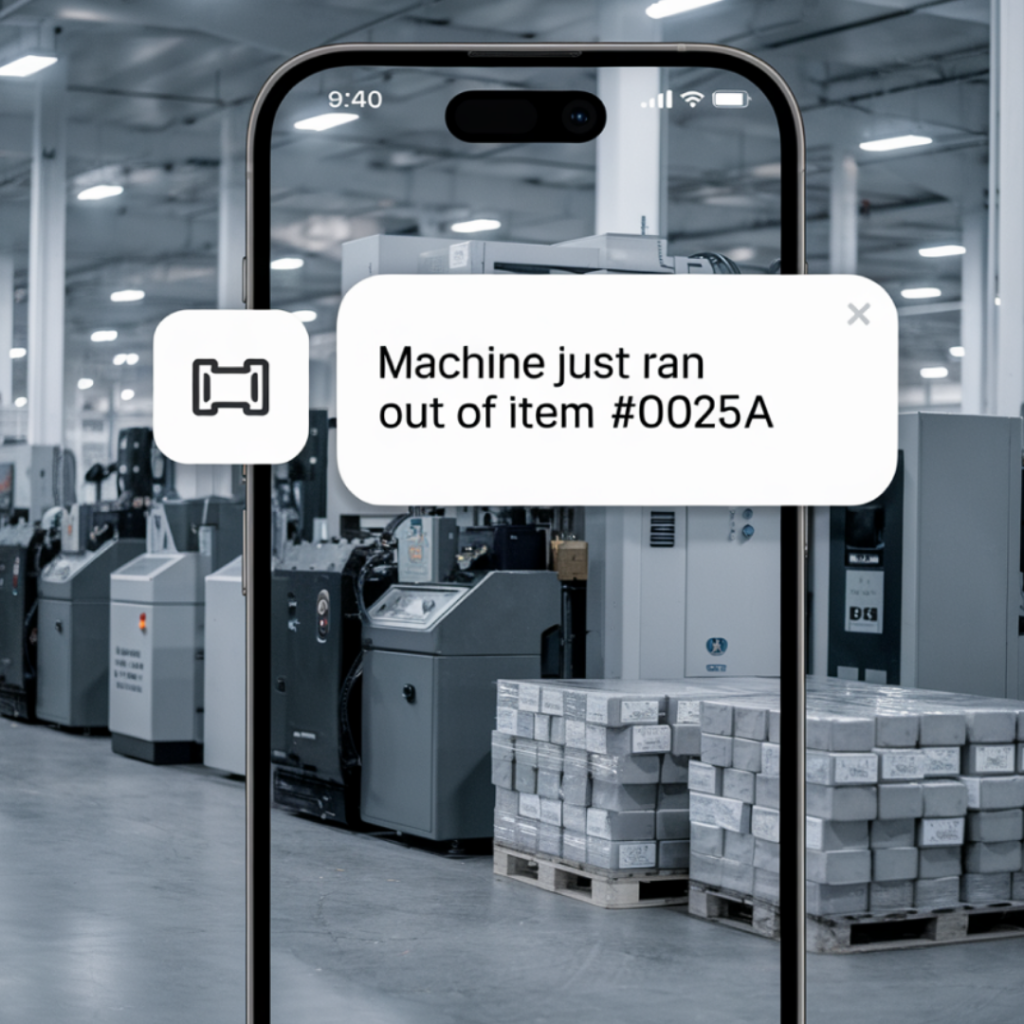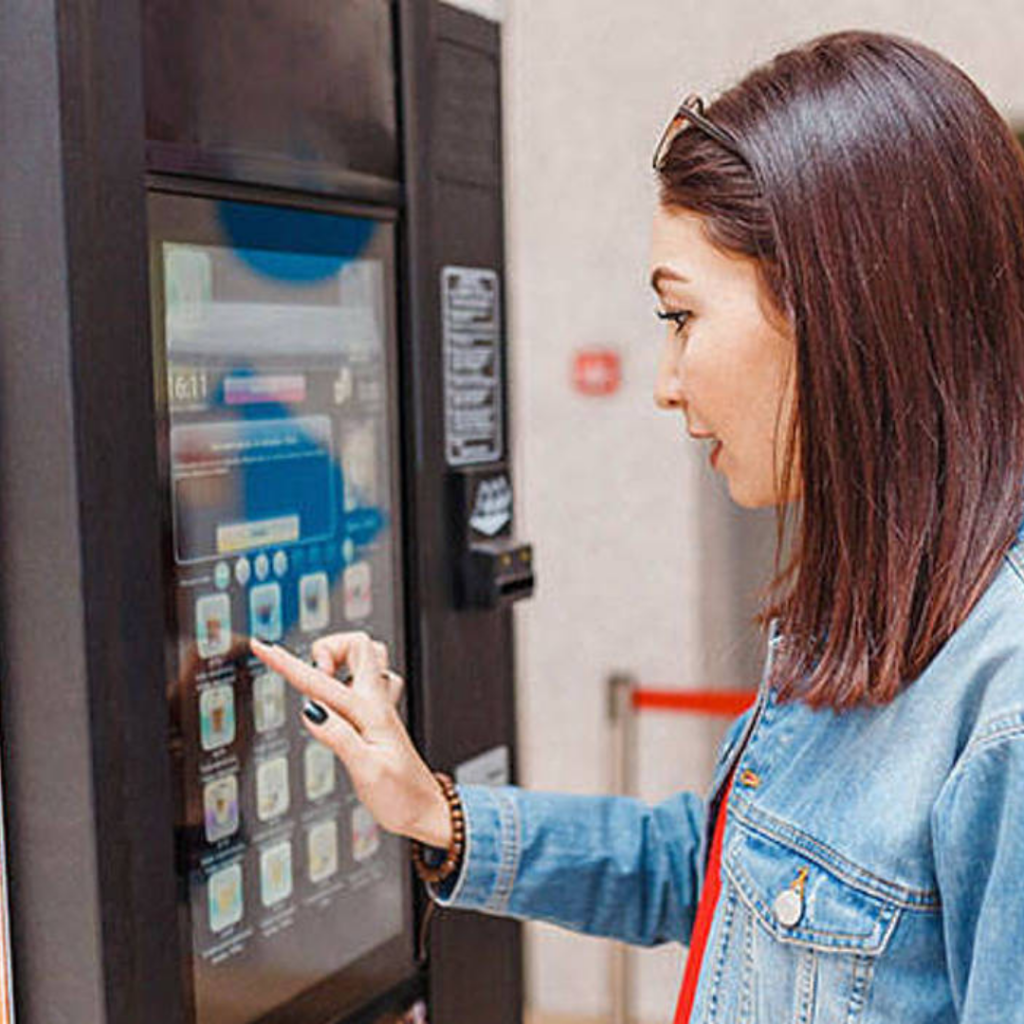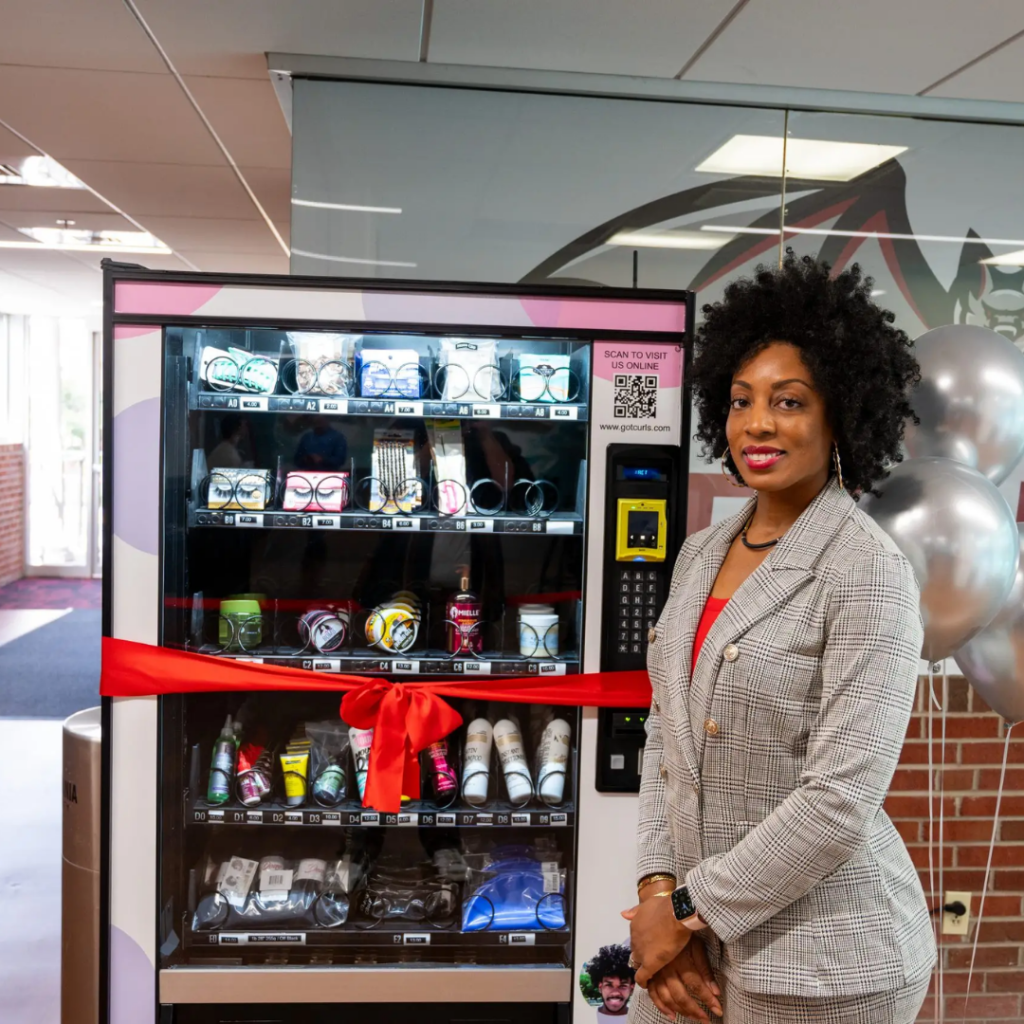Export ready American built machines in stock, shipping from Miami
How To Start An Ice Cream Business With Vending Machines
Introduction: Why Ice Cream and Vending Machines Work Together
How to start an ice cream business does not have to mean renting a storefront or hiring staff. A modern approach uses ice cream vending machines that sell automatically, day and night. This model blends the fun of ice cream with the reliability of automated sales.
Ice cream is an easy impulse buy. People of every age enjoy it after meals, at work, or while shopping. Because of that, it performs well in high-traffic areas and earns seasonal boosts during warm months. New vending machines keep the product cold, display it attractively, and handle every sale without supervision.
Today’s brand new vending machines accept cashless payments and connect to cloud software for monitoring stock and temperature. A big screen ice cream vending machine can even promote flavors or special offers. Combined with smart placement and flexible financing, operators can start small, add more locations, and grow fast.
This guide explains each step — from setup and product sourcing to operations and expansion — so you can build a profitable ice cream vending machine business with confidence.
The Business Model: Ice Cream Vending Machine Setup
An ice cream vending machine business combines automation, location strategy, and simple operations. The core idea is to place a refrigerated unit in a busy area, keep it stocked with frozen novelties, and let it sell around the clock. Every sale happens automatically, which makes this model low-labor and easy to manage.
There are several types of ice cream vending machines for sale. Some units hold pre-packaged bars and cups, while others dispense soft-serve ice cream. The pre-packaged style works best for new operators because it needs little cleaning and stays consistent in quality. Smart payment systems accept cards and mobile wallets, which helps attract impulse buyers who no longer carry cash.
Modern machines connect to cloud software for remote monitoring. You can track inventory, sales, and temperature from your phone. Revenue comes from product margins minus costs like restocking, power, and the small commission paid to the site owner. With strong locations and reliable equipment, operators can turn one machine into a scalable business.
Key Benefits and What to Watch Out For
Why Ice Cream Vending Machines Stand Out
Ice cream vending machines offer several clear advantages. Once installed, they sell automatically with no staff on site. This reduces labor costs and simplifies daily operations. Because the machines run nonstop, they can serve customers long after regular stores close. In addition, overhead costs stay low compared to a full retail shop since you use less space, power, and equipment.
Scalability is another strength. Operators can start with one unit, test performance, and expand into new locations as profits grow. Flexible financing also makes it easier to purchase more machines quickly. These traits make the model appealing for both beginners and experienced vending investors.
Challenges to Plan For
However, success depends heavily on placement. A weak site can mean slow sales. Machine maintenance is also essential since freezer or temperature issues can lead to spoilage. Outdoor units face seasonal drops in winter and must handle heat in summer. Finally, venue owners may ask for rent or a sales commission, which affects margins. With planning and regular monitoring, these risks can be controlled.
Choosing the Right Machine and Technology
Selecting the right equipment is one of the most important steps in building a successful ice cream vending machine business. The ideal machine must hold frozen items at the proper temperature, present products attractively, and operate dependably in your chosen environment. A quality unit prevents spoilage, reduces service calls, and keeps customers satisfied.
For most operators, the best choice is a frozen-novelty model designed for pre-packaged bars, cups, and sandwiches. These machines stay colder and are easier to restock than soft-serve units, which require daily cleaning and more maintenance. When comparing ice cream vending machines for sale, check the refrigeration capacity, energy efficiency, and overall footprint to ensure it fits your site’s power and space limits.
Technology plays a key role. Modern brand new vending machines include cashless payment systems that accept cards, mobile wallets, and contactless options. Many also link to cloud software for live data on sales, temperature, and stock levels. This makes remote management easier and prevents downtime. Machines with a big screen ice cream vending machine display can show videos or flavor ads, which attract attention and boost impulse purchases.
Before buying, review warranty terms, service contracts, and spare part availability. A strong supplier relationship ensures help when needed and protects your investment as your network expands into new locations.
Location Strategy: Where to Place Your Ice Cream Vending Machine
Why Location Matters
The success of any ice cream vending machine business depends heavily on where each unit is placed. A high-traffic, well-lit, and visible site can double or even triple your daily sales compared to a poor one. Ice cream is an impulse purchase, so positioning your machine where people naturally stop, relax, or wait increases the chance of a sale.
Understanding Customer Flow
Before selecting a site, observe how people move through it. Ideal spots have consistent pedestrian traffic throughout the day rather than short bursts. Families, students, tourists, and shift workers tend to buy more frozen treats because they have short breaks and seek quick satisfaction. Indoor sites provide steady revenue year-round, while outdoor ones excel in summer months.
Best Performing Indoor Locations
Shopping malls, amusement parks, hospitals, airports, and universities rank among the most profitable sites. These venues combine high visitor volume with long dwell times, giving customers a reason to make small impulse purchases. Factories and distribution centers also perform well, especially when machines are placed in break areas accessible to workers on multiple shifts.
Outdoor and Seasonal Opportunities
Outdoor vending can be lucrative when managed carefully. Beaches, parks, and recreation areas are perfect for warm-weather months, but require well-insulated machines and reliable power connections. Consider weather-resistant enclosures to protect both the unit and the products. For operators in colder climates, rotate machines indoors during off-season periods to maintain consistent income.
Negotiating Placement Agreements
When securing a location, present your machine as an added convenience that enhances the site’s amenities. Offer a fair revenue share, often 10–25 percent of gross sales, or a fixed monthly rent depending on the property owner’s preference. Clarify key details such as exclusivity, signage rights, cleaning responsibility, and access to electricity. A clear, written agreement helps build lasting relationships with venue partners.
Evaluating Site Performance
After installation, monitor sales closely for at least one month. If results are below expectations, analyze traffic flow, visibility, or competition nearby. The best ice cream vending machines deliver consistent performance when placed in environments that combine high traffic, good visibility, and reliable access to power. Over time, these strong sites form the backbone of a profitable and scalable vending operation.
Cost, Financing, and Profitability Analysis
Understanding Upfront Costs
Starting an ice cream vending machine business requires planning for several initial expenses. The biggest cost is the machine itself. A high-quality frozen-food vending unit that holds around 200 items typically ranges from $4,000 to $6,500 depending on size, payment technology, and freezing capability. For example, some models listed by vending suppliers such as Vencoa are priced near $4,495 delivered. Additional setup costs may include delivery, power installation, shipping, and required local permits or food licenses.
Operating Expenses to Expect
Once your machine is installed, operating costs become your main expense. These include electricity for refrigeration, restocking labor, maintenance, product cost, and site commission or rent
Cost, Financing, and Profitability Analysis
Understanding Upfront Costs
Starting an ice cream vending machine business requires planning for several initial expenses. The biggest cost is the machine itself. A high-quality frozen-food vending unit that holds around 200 items typically ranges from $4,000 to $6,500 depending on size, payment technology, and freezing capability. For example, some models listed by vending suppliers such as Vencoa are priced near $4,495 delivered. Additional setup costs may include delivery, power installation, shipping, and required local permits or food licenses.
Operating Expenses to Expect
Once your machine is installed, operating costs become your main expense. These include electricity for refrigeration, restocking labor, maintenance, product cost, and site commission or rent. Power consumption varies by environment, but most ice cream vending machines use about 7–14 kWh per day, translating to $25–$60 per month. Regular cleaning and preventive maintenance help avoid compressor or cooling issues that can lead to product loss.
Product and Wholesale Pricing
Ice cream novelties are usually purchased wholesale in boxes of 12 to 24 units. Supplier data shows average costs from $0.35 to $1.75 per item, depending on size and brand. For example, Blue Bunny Cookies & Cream Bars sell at roughly $0.81 each, while Dove Vanilla Bars are closer to $1.67. Adding shipping, spoilage, and restocking costs provides a true product cost per unit. Operators typically price each item between $2.50 and $4.00, leaving a comfortable margin even after commission fees.
Revenue Model and Break-Even Example
Profitability depends on daily sales volume and location quality. If one machine sells 40 units per day at an average $3.00 price point with a $1.00 profit margin, it can generate about $1,200 in net profit per month after covering expenses. At that rate, an initial investment of $5,000 could break even within five to six months. Lower traffic or higher rent can extend that timeline, which makes site selection critical.
Financing Options
For operators who prefer not to buy equipment outright, many suppliers offer financing or leasing programs. Monthly payments often range from $150 to $250, allowing beginners to start with minimal capital. Some financing plans even include extended warranties and service support. Pairing these options with the right locations can make scaling your operation faster and more affordable.
Evaluating Profit Potential
When managed correctly, an ice cream vending operation delivers steady passive income and strong seasonal spikes. Tracking sales data, adjusting product mix, and maintaining consistent service help maximize profits. Over time, the right combination of cost control, reliable machines, and premium locations will determine your long-term success.
Product Selection, Branding, and Customer Experience
Building the Right Product Mix
Strong product selection defines the success of your ice cream vending machine business. Start with proven sellers that appeal across ages and seasons. The best mix includes perennial favorites such as chocolate, vanilla, and strawberry, combined with novelty options like cookie dough or mint chip. Since vending machines rely on speed and consistency, choose individually wrapped novelties that dispense cleanly and stay frozen without melting or sticking inside the unit.
Famous and Reliable Ice Cream Brands
Partnering with well-known brands builds instant trust with buyers. Customers recognize these names and associate them with quality, which increases impulse sales. Below is a comparison of popular wholesale ice cream products commonly used in ice cream vending machines across the U.S. market:
| Brand & Product | Case Size | Approx. Case Price (USD) | Approx. Cost per Unit |
|---|---|---|---|
| Blue Bunny Cookies & Cream Ice Cream Bar | 24-count | $19.50 | $0.81 per unit |
| Dove Vanilla Ice Cream Bar | 12-count | $19.99 | $1.67 per unit |
| Nestlé Drumstick Vanilla Cone | 24-count | $24.50 | $1.02 per cone |
| Snickers Ice Cream Bar | 24-count | $25.00 | $1.04 per bar |
Operators usually retail these items between $2.50 and $4.00 each, depending on the brand and venue. Maintaining a 50–65 percent gross margin per unit ensures healthy profit while keeping prices competitive for impulse buyers.
Packaging and Product Format
Choose packaging that works seamlessly with your machine. Flat, rectangular bars, cups with sealed lids, and sandwich formats are the most vending-friendly shapes. Avoid soft-serve or open containers that require extra temperature control or utensils. Packaging should remain visible through the glass panel and be bright enough to catch attention even from a distance. Always verify that packaging is “vending safe,” meaning it holds its structure at sub-zero temperatures.
Branding and Machine Presentation
How your machine looks directly affects how customers perceive your ice cream. A well-decorated machine with vibrant product imagery and brand logos signals quality. Use high-resolution graphics from the manufacturers you carry. Modern brand new vending machines often feature LED lighting and a big screen ice cream vending machine interface that plays product videos or flavor slideshows. These visual elements can lift sales by 15–25 percent, especially in crowded retail environments.
Customer Experience and Data Tracking
Customers value convenience and trust. Ensure every unit accepts multiple payment types—credit, debit, and contactless—so no sale is lost. Through cloud software, you can monitor product performance, identify top flavors, and schedule restocks based on real sales data. This feedback loop helps you retire slower items and introduce trending flavors. Rotate seasonal offerings—such as fruit bars in summer and richer chocolate flavors in winter—to maintain customer interest throughout the year.
Final Product Strategy Tip
Start with five to seven products that balance brand power, price range, and flavor diversity. Test combinations for two to three months, review sales analytics, and refine your lineup. With recognizable brands, strong packaging, and consistent vending performance, your ice cream vending machines will attract repeat buyers and maintain healthy margins year-round.
Operations, Maintenance, and Logistics
Establishing a Restocking Routine
Efficient operations keep your ice cream vending machines profitable and reliable. Restocking frequency depends on sales volume, product variety, and machine capacity. A fully stocked unit that holds 200 items typically needs refilling every three to five days in busy indoor sites, or weekly in moderate traffic areas. High-performing locations such as malls or airports may require daily visits during summer months. Always transport products in insulated containers to maintain the cold chain and prevent partial thawing.
Product Rotation and Freshness
Even frozen novelties have shelf-life limits. Track expiration dates and rotate older stock forward during each refill. Use cloud software to monitor inventory levels, temperature data, and sales by product. This system helps identify slow-moving items before they expire. Adjust your product mix seasonally—lighter fruit bars in warmer months and richer chocolate or caramel flavors in winter—to match customer preferences and reduce waste.
Preventive Maintenance
Regular maintenance prevents breakdowns and extends machine life. Inspect compressors, door seals, and ventilation grills during every service visit. Clean the internal surfaces to remove frost buildup, which can restrict airflow and raise energy use. Defrosting may be required every few months depending on humidity levels. Pay close attention to the condenser fan and evaporator coil; minor cleaning can prevent major cooling failures. For electronic issues such as card reader errors, maintain a service log to track recurring faults and schedule repairs promptly.
Remote Monitoring and Downtime Alerts
Modern brand new vending machines are equipped with sensors that send alerts through remote monitoring systems. These alerts notify you if temperature rises, a door is left open, or a machine goes offline. Quick response prevents spoilage and lost sales. Real-time data also enables predictive maintenance—recognizing when a compressor or motor shows irregular patterns before complete failure.
Site Servicing Agreements
Maintain strong relationships with property owners where your machines are placed. Clarify responsibilities for cleaning around the unit, electrical access, and security. Many operators sign site servicing agreements that outline power costs, rental terms, and response time for malfunctions. A clear plan keeps operations smooth and builds trust between both parties.
Risk Management and Insurance
Risk management protects your investment. Power outages, theft, vandalism, or spoilage can cause unexpected losses. Install surge protectors and use backup power where possible. Choose insurance that covers equipment, liability, and perishable inventory. Document all maintenance and restocking activities for accountability and warranty claims. With these systems in place, your ice cream vending machine business runs efficiently and delivers consistent, hands-free revenue.
Scaling and Growth Strategy
Expanding Beyond the First Machine
Once your first ice cream vending machine runs smoothly and consistently turns a profit, expansion becomes the next step. Scaling can mean adding more machines to new locations, diversifying product lines, or upgrading to advanced units with smart technology. Use performance data from your initial site to identify what works best—sales trends, foot traffic patterns, and customer preferences. Replicating proven setups reduces risk and speeds growth.
Reinvesting in Smart Equipment
Profits from early machines can fund upgrades to brand new vending machines that support larger inventories, energy efficiency, and better marketing tools. Look for models with remote monitoring, cashless payment options, and integrated cloud software. Machines with a big screen ice cream vending machine display can advertise new flavors, promotions, or seasonal campaigns directly to customers, boosting both engagement and sales.
Leveraging Data for Smarter Growth
Sales data is your best guide for scaling. Cloud-based dashboards reveal which products sell fastest, what times of day generate the most purchases, and which sites underperform. Use this data to decide where to add or relocate machines. When negotiating new venue agreements, present sales reports from existing sites as proof of performance—this builds confidence with property owners and can help you secure prime placements or lower commissions.
Diversifying Your Product Offering
Once your ice cream operation is stable, consider diversifying into snacks, frozen beverages, or combo machines that offer both ice cream and cold drinks. Hybrid units increase average revenue per transaction and attract more customers. Some operators even partner with local dessert brands or seasonal suppliers to introduce exclusive flavors, which helps differentiate your machines from competitors nearby.
Financing and Scaling Strategies
To grow faster, explore financing options that spread the cost of new machines over time. Leasing multiple units at once allows you to secure better supplier discounts and site deals. Some financing partners also offer location-matching services, helping you expand into shopping malls, hospitals, or entertainment complexes without spending months on research. As your network grows, negotiate better wholesale pricing from distributors by purchasing in larger volumes.
Brand Consistency and Long-Term Goals
As your ice cream vending machine business expands, maintain consistent branding and service standards. Keep machines clean, well-stocked, and visually uniform across all sites. Customers who recognize your brand will trust it and repurchase more often. Review operations quarterly, evaluate machine performance, and upgrade equipment as needed. Scaling gradually with a data-driven strategy ensures sustainable growth and long-term profitability.
Conclusion and Next Steps
Why Ice Cream Vending Machines Are a Smart Business Choice
For entrepreneurs researching how to start an ice cream business, vending machines provide one of the most efficient entry points. They combine automation, low overhead, and strong consumer demand in a model that can operate almost anywhere. Because ice cream appeals to all age groups and seasons, your ice cream vending machines can deliver steady profits year-round when placed strategically and maintained properly.
Keys to Long-Term Success
Profitable vending operations rely on three essentials: the right location, reliable equipment, and quality products. Choose proven indoor and outdoor locations that attract repeat customers. Invest in brand new vending machines with durable freezing systems, cloud software for remote monitoring, and versatile payment options. Stock trusted brands that customers already love, keep machines clean and well-lit, and analyze sales data regularly to guide decisions.
Planning for Sustainable Growth
Start small, perfect your process, and scale only after your first site runs profitably. As you expand, diversify into new venues and use financing tools to add more units without heavy upfront costs. Build long-term relationships with property owners and distributors, and keep refining your product mix to match customer preferences. With consistency and attention to detail, each new site strengthens your brand and revenue base.
Practical Next Steps
Before launching your business, follow this simple checklist:
- Research and compare ice cream vending machines for sale that meet your size, power, and payment needs.
- Identify and visit at least five potential locations with high traffic and solid electrical access.
- Secure financing or leasing for your first unit and confirm delivery timeline.
- Contact product distributors for wholesale pricing and test a balanced product mix.
- Install, monitor, and track performance for 30–60 days using cloud-based software.
- Evaluate results, adjust strategy, and plan the next placement once the first site proves profitable.
Final Thought
With the right mix of planning, technology, and dedication, an ice cream vending machine business can grow from a single unit to a scalable network of automated dessert outlets. Start with one well-chosen site, learn from the data, and expand confidently—your next great opportunity could be waiting in the next location you serve.


